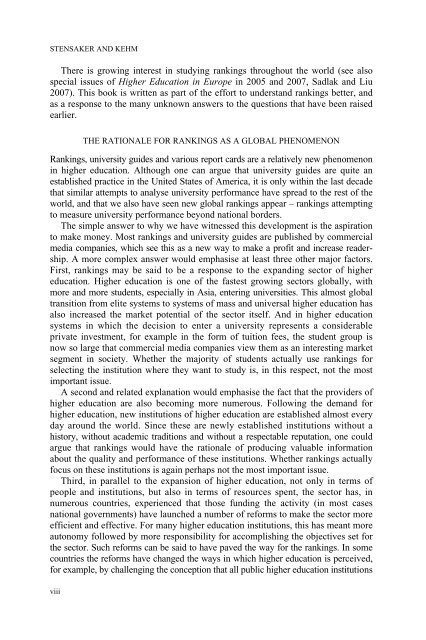University Rankings, Diversity, and the New ... - Sense Publishers
University Rankings, Diversity, and the New ... - Sense Publishers
University Rankings, Diversity, and the New ... - Sense Publishers
You also want an ePaper? Increase the reach of your titles
YUMPU automatically turns print PDFs into web optimized ePapers that Google loves.
STENSAKER AND KEHM<br />
There is growing interest in studying rankings throughout <strong>the</strong> world (see also<br />
special issues of Higher Education in Europe in 2005 <strong>and</strong> 2007, Sadlak <strong>and</strong> Liu<br />
2007). This book is written as part of <strong>the</strong> effort to underst<strong>and</strong> rankings better, <strong>and</strong><br />
as a response to <strong>the</strong> many unknown answers to <strong>the</strong> questions that have been raised<br />
earlier.<br />
viii<br />
THE RATIONALE FOR RANKINGS AS A GLOBAL PHENOMENON<br />
<strong>Rankings</strong>, university guides <strong>and</strong> various report cards are a relatively new phenomenon<br />
in higher education. Although one can argue that university guides are quite an<br />
established practice in <strong>the</strong> United States of America, it is only within <strong>the</strong> last decade<br />
that similar attempts to analyse university performance have spread to <strong>the</strong> rest of <strong>the</strong><br />
world, <strong>and</strong> that we also have seen new global rankings appear – rankings attempting<br />
to measure university performance beyond national borders.<br />
The simple answer to why we have witnessed this development is <strong>the</strong> aspiration<br />
to make money. Most rankings <strong>and</strong> university guides are published by commercial<br />
media companies, which see this as a new way to make a profit <strong>and</strong> increase readership.<br />
A more complex answer would emphasise at least three o<strong>the</strong>r major factors.<br />
First, rankings may be said to be a response to <strong>the</strong> exp<strong>and</strong>ing sector of higher<br />
education. Higher education is one of <strong>the</strong> fastest growing sectors globally, with<br />
more <strong>and</strong> more students, especially in Asia, entering universities. This almost global<br />
transition from elite systems to systems of mass <strong>and</strong> universal higher education has<br />
also increased <strong>the</strong> market potential of <strong>the</strong> sector itself. And in higher education<br />
systems in which <strong>the</strong> decision to enter a university represents a considerable<br />
private investment, for example in <strong>the</strong> form of tuition fees, <strong>the</strong> student group is<br />
now so large that commercial media companies view <strong>the</strong>m as an interesting market<br />
segment in society. Whe<strong>the</strong>r <strong>the</strong> majority of students actually use rankings for<br />
selecting <strong>the</strong> institution where <strong>the</strong>y want to study is, in this respect, not <strong>the</strong> most<br />
important issue.<br />
A second <strong>and</strong> related explanation would emphasise <strong>the</strong> fact that <strong>the</strong> providers of<br />
higher education are also becoming more numerous. Following <strong>the</strong> dem<strong>and</strong> for<br />
higher education, new institutions of higher education are established almost every<br />
day around <strong>the</strong> world. Since <strong>the</strong>se are newly established institutions without a<br />
history, without academic traditions <strong>and</strong> without a respectable reputation, one could<br />
argue that rankings would have <strong>the</strong> rationale of producing valuable information<br />
about <strong>the</strong> quality <strong>and</strong> performance of <strong>the</strong>se institutions. Whe<strong>the</strong>r rankings actually<br />
focus on <strong>the</strong>se institutions is again perhaps not <strong>the</strong> most important issue.<br />
Third, in parallel to <strong>the</strong> expansion of higher education, not only in terms of<br />
people <strong>and</strong> institutions, but also in terms of resources spent, <strong>the</strong> sector has, in<br />
numerous countries, experienced that those funding <strong>the</strong> activity (in most cases<br />
national governments) have launched a number of reforms to make <strong>the</strong> sector more<br />
efficient <strong>and</strong> effective. For many higher education institutions, this has meant more<br />
autonomy followed by more responsibility for accomplishing <strong>the</strong> objectives set for<br />
<strong>the</strong> sector. Such reforms can be said to have paved <strong>the</strong> way for <strong>the</strong> rankings. In some<br />
countries <strong>the</strong> reforms have changed <strong>the</strong> ways in which higher education is perceived,<br />
for example, by challenging <strong>the</strong> conception that all public higher education institutions














